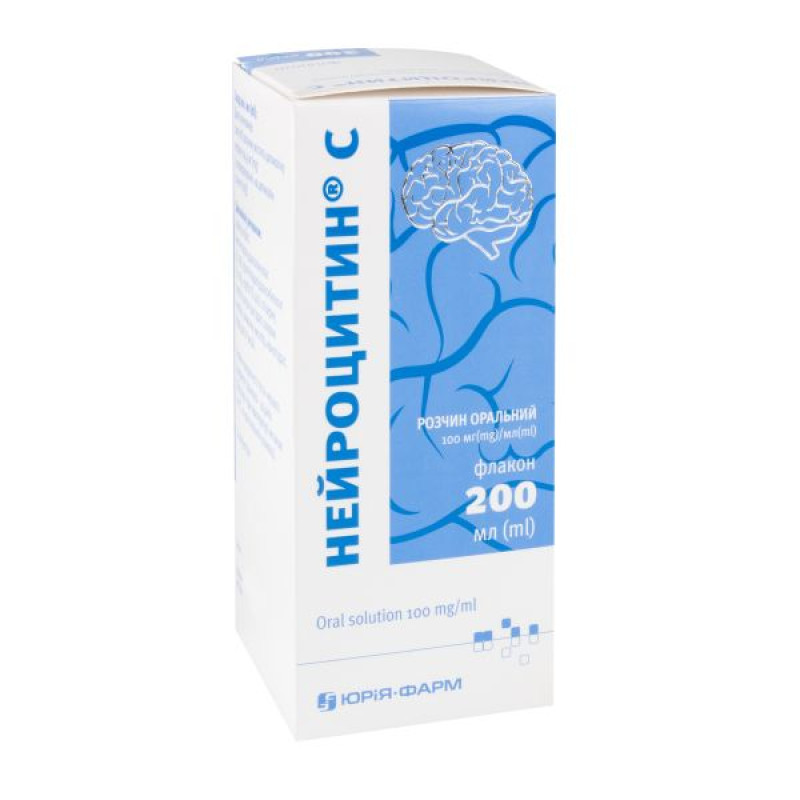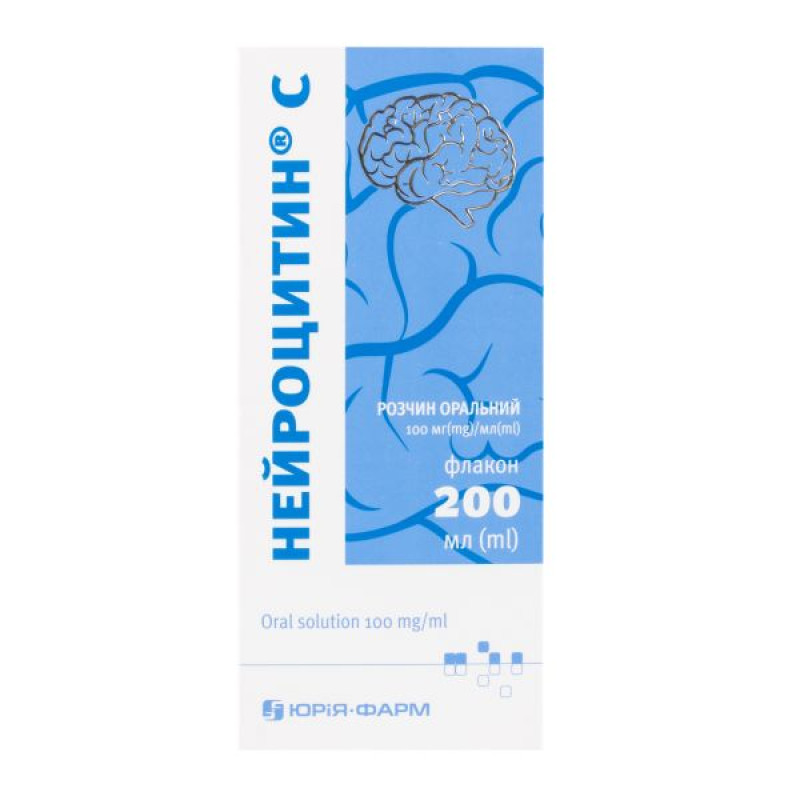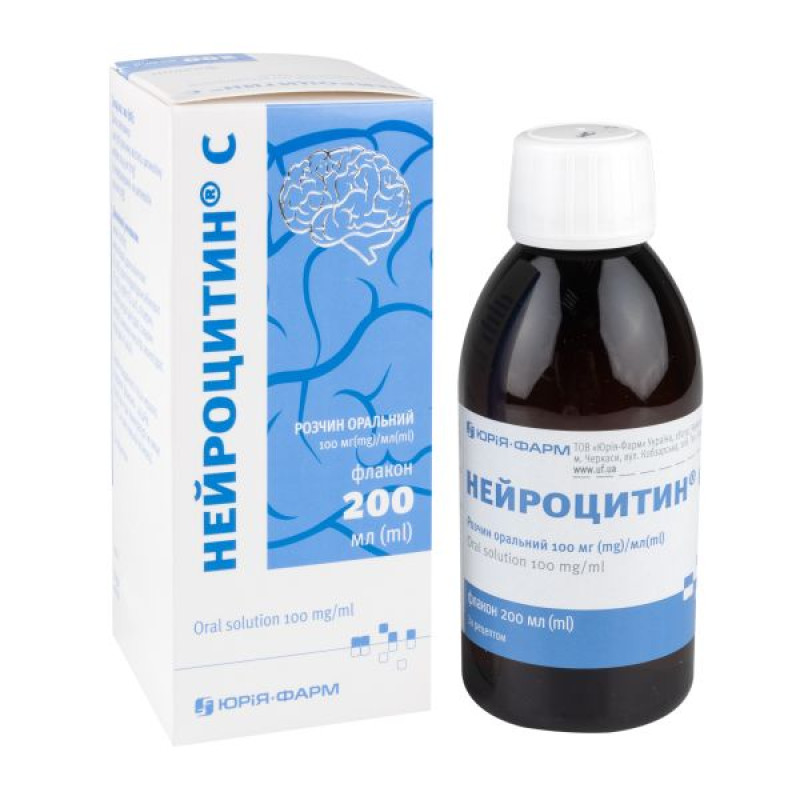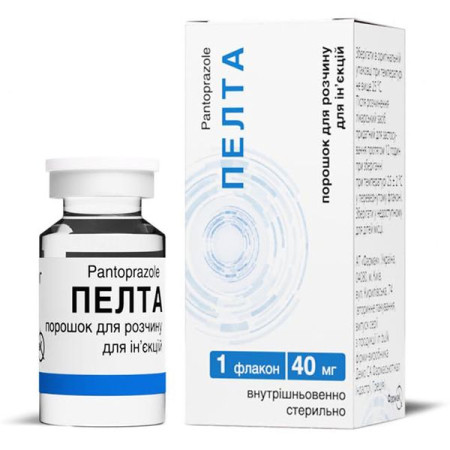Neurocytin C oral solution 100 mg/ml 200 ml

Instructions Neurocytin C oral solution 100 mg/ml 200 ml
Composition
active ingredient: citicoline;
1 ml of solution contains 104.5 mg of citicoline sodium (equivalent to 100 mg of citicoline);
Excipients: potassium sorbate; methyl parahydroxybenzoate (E 218); propyl parahydroxybenzoate (E 216); sorbitol (E 420); glycerol; sodium citrate dihydrate; sodium saccharin; citric acid, monohydrate; water for injections.
Dosage form
Oral solution.
Main physicochemical properties: transparent colorless or slightly yellowish viscous solution.
Pharmacotherapeutic group
Agents acting on the nervous system. Psychoanaleptics. Psychostimulants, agents for use in attention deficit hyperactivity disorder (ADHD) and nootropics. Other psychostimulants and nootropics. Citicoline.
ATX code N06B X06.
Pharmacological properties
Pharmacodynamics
Citicoline stimulates the biosynthesis of structural phospholipids of neuronal membranes, which is confirmed by magnetic resonance spectroscopy. Due to this mechanism of action, citicoline improves the functioning of such membrane mechanisms as the work of ion exchange pumps and receptors, the modulation of which is necessary for the normal conduction of nerve impulses.
Due to its stabilizing effect on the neuronal membrane, citicoline exhibits anti-edema properties that help reduce brain edema.
Clinical studies have shown that citicoline inhibits the activation of certain phospholipases (A1, A2, C, and D), reducing the formation of free radicals, preventing the destruction of membrane systems, and preserving antioxidant defense systems such as glutathione.
Citicoline preserves neuronal energy reserves and inhibits apoptosis, which improves cholinergic transmission.
It has been experimentally proven that citicoline also has a preventive neuroprotective effect in focal cerebral ischemia.
Clinical studies have shown that citicoline significantly increases functional recovery rates in patients with acute stroke, which coincides with a slowdown in the growth of ischemic brain damage according to neuroimaging data.
In patients with traumatic brain injury, citicoline accelerates recovery and reduces the duration and intensity of post-traumatic syndrome.
Citicoline improves the level of attention and consciousness, helps reduce the manifestations of amnesia, cognitive and other neurological disorders associated with cerebral ischemia.
Pharmacokinetics
Citicoline is well absorbed after oral, intramuscular and intravenous administration. Plasma choline levels increase significantly after administration by the above routes. Citicoline is almost completely absorbed after oral administration and the bioavailability is almost the same as after intravenous administration.
Depending on the route of administration, the drug is metabolized in the intestine, liver to choline and cytidine. After administration, citicoline is widely distributed in brain structures with rapid incorporation of the choline fraction into structural phospholipids and the cytidine fraction into cytidine nucleotides and nucleic acids. Having reached the brain, citicoline is incorporated into cellular, cytoplasmic and mitochondrial membranes, participating in the construction of the phospholipid fraction.
Only a small amount of the dose is excreted in the urine and feces (less than 3%). Approximately 12% of the dose is excreted in exhaled CO2. There are two phases in the excretion of the drug in the urine: the first phase is approximately 36 hours, in which the rate of excretion decreases rapidly, and the second phase is in which the rate of excretion decreases much more slowly. The same phasic pattern is observed in excretion with CO2: the rate of exhaled CO2 excretion decreases rapidly after approximately 15 hours, then it decreases much more slowly.
Indication
Stroke, acute phase of cerebrovascular disorders and treatment of complications and consequences of cerebrovascular disorders.
Traumatic brain injury and its neurological consequences.
Cognitive and behavioral disorders due to chronic vascular and degenerative cerebral disorders.
Contraindication
Hypersensitivity to citicoline or to any of the excipients of the drug.
Increased tone of the parasympathetic nervous system.
Interaction with other medicinal products and other types of interactions
The drug should not be used simultaneously with medicines containing meclofenoxate.
Citicoline enhances the effect of levodopa.
Application features
Neurocytin® C, oral solution, contains sorbitol, therefore, if the patient has been diagnosed with an intolerance to some sugars, it is necessary to consult a doctor before taking this medicine.
Methyl parahydroxybenzoate (E 218) and propyl parahydroxybenzoate (E 216), which are contained in the preparation, may cause allergic reactions (possibly delayed).
Neurocytin® C contains:
0.476 mmol (or 10.95 mg) of sodium in 1 ml of the medicinal product;
9.52 mmol (or 219 mg) sodium per 20 ml of medicinal product. Caution should be exercised when administering this medicine to patients on a controlled sodium diet.
The medicine contains a small amount of glycerin – 1 g per 20 ml of the drug, which is safe and has no effect on the patient's body.
Use during pregnancy or breastfeeding
There are no adequate data on the use of citicoline in pregnant women. There are no data on the excretion of citicoline into breast milk and its effect on the fetus. Therefore, during pregnancy or breastfeeding, the drug should be prescribed only if the expected benefit to the mother outweighs the potential risk to the fetus.
Ability to influence reaction speed when driving vehicles or other mechanisms
In some cases, some adverse reactions from the central nervous system may affect the ability to drive and operate complex mechanisms.
Method of administration and doses
For internal use.
The recommended dose of Neurocytin® C for adults is from 500 mg (5 ml) to 2000 mg (20 ml) per day, which should be divided into 2–3 doses. Take regardless of meals.
The drug should be taken using an oral syringe according to the following scheme:
Before use, the oral syringe plunger should be fully depressed.
Pull back the plunger and draw the required dose, taking into account that the amount of liquid in the oral syringe must correspond to the prescribed dose.
Take the drug directly from the oral syringe or after mixing it with a small amount of water (120 ml).
It is necessary to rinse the oral syringe with water after each use.
The dosage of the drug and the duration of treatment depend on the severity of the brain lesions and are determined individually by the doctor.
Elderly patients.
Do not require dose adjustment.
Children
Experience with the use of the drug in children is limited.
Overdose
Cases of overdose have not been described.
Side effects
The adverse reactions listed below are classified by system organ class and frequency. The frequency of occurrence is classified as common (≥ 1/100 - < 1/10), uncommon (≥ 1/1000 - <1/100), rare (≥ 1/10000 - < 1/1000), very rare (< 1/10000), frequency unknown (cannot be estimated from the available data).
Adverse reactions occur very rarely (<1/10,000), including isolated cases.
Neurological disorders: severe headache, vertigo, hallucinations.
From the cardiovascular system: arterial hypertension, arterial hypotension, tachycardia.
Respiratory, thoracic and mediastinal disorders: dyspnea.
Gastrointestinal disorders: nausea, vomiting, diarrhea.
On the part of the immune system: allergic reactions, including: rash, hyperemia, exanthema, urticaria, purpura, itching, angioedema, anaphylactic shock.
General reactions: chills.
Expiration date
2 years.
The shelf life after first opening the bottle is 40 days.
Storage conditions
Store at a temperature not exceeding 25 °C in the original packaging.
Keep out of reach of children.
Packaging
30 ml, or 100 ml, or 200 ml of solution in a polymer bottle. 1 bottle together with an oral syringe in a cardboard pack.
Vacation category
According to the recipe.
Producer
LLC "Yuria-Pharm".
Location of the manufacturer and address of its place of business
Ukraine, 18030, Cherkasy region, Cherkasy city, Kobzarska st., 108. Tel.: (044) 281-01-01.
There are no reviews for this product.
There are no reviews for this product, be the first to leave your review.
No questions about this product, be the first and ask your question.









